When debating which ecommerce platform to consider, it’s important to learn the advantages and disadvantages of each option.
Shopify is almost always in the conversation, so we’ll outline all Shopify pros and cons to help ensure you’re making the right decision.
Shopify Pros and Cons Quick Summary
Pros 👍
- All the Essentials are Included
- An Industry-leading Customer Support Team
- Sell Anything You Want—Physical, Digital, Bundled, Etc.
- Built-in Security
- Incredible Payment Processing Support
- Beautiful Themes and Easy Design Tools
- Shopify Has The Best App Store You Can Find
- A Powerful, Integrated Point of Sale
- It’s a Popular, Growing Platform
- Built-in Marketing and Advertising Tools
- Seamless Fulfillment and Product Sourcing Options
- There’s a Cheap Plan for Content Creators
Cons 👎
- Never-ending Payments
- Transaction Fees for Non-Shopify Payment Processing
- Limited Free Themes and Expensive Paid Themes
- Apps Can Get Expensive
- It’s Tough to Migrate Away from Shopify
- Less Popular Coding Language
- The Limited Blogging Interface
In this article:
Reasons to Learn About Shopify Pros and Cons
Shopify has an impressive track record. It’s secure, affordable, and an all-in-one ecommerce store builder that’s suitable for beginners and advanced users alike.
So, what’s the point of learning about the Shopify pros and cons?
- Learning the pros may lead you to Shopify features you didn’t know existed.
- Although there aren’t nearly as many cons, having the knowledge about them ensures you’re ready to tackle any ease-of-use obstacles that may arise.
- Some of the pros and cons may not apply to your ecommerce business; so, if someone says to choose/skip Shopify because of this pro/con, that may actually push you away/towards Shopify even more.
- Pros and cons help you visualize what’s being paid for, allowing you to see the value in your purchase.
- Pros and cons provide more ways to compare with other platforms. For instance, you may find that Bigcommerce has some of the same cons as Shopify, or that one of the pros of Shopify makes it stand out from the competition.
With that said, keep reading to explore all the Shopify pros and cons!
Shopify Pros and Cons – Video
Instead of reading, you can watch this video where we explore in more detail the advantages and potential challenges that come with using Shopify as your platform..

Shopify Pros
From Shopify’s all-in-one ecommerce offerings to its rather seamless fulfillment options, it definitely has more pros than cons. In this section, we go in-depth about Shopify’s advantages to help you see what you’re paying for.
Shopify Pro #1: All the Essentials are Included
Hosting: that’s included. A subdomain: that’s included. Domain purchasing: included.

The same can be said for ecommerce site building, inventory management, order management, marketing tools, advertising, discount codes, blogging, abandoned cart recovery, multiple currencies, payment options, shipping rates, product sourcing, omnichannel selling, and much more.
The whole idea behind Shopify is for merchants to have all the tools they need to launch an ecommerce website for selling products.
Shopify supports the selling of unlimited products, and that includes digital and bundled products as well. You even get a full library of professionally designed templates, along with thousands of add-ons to extend the functionality of your store.
The reason all of this is so important is that many self-hosting website builders function as more of a patchwork of tools.
They offer additional control, and often a free platform, but you’re then left to find your own hosting, pay for a domain through a 3rd party, and install elements for optimization, security, and search engine optimization, most of which come from 3rd-party developers.
Needless to say, competitors like WordPress (WooCommerce) and Magento are more advanced to work with, since you’re piecing together several elements, all of which are developed by different people. That means separate payment accounts, dashboards, and an overall more confusing setup.
Shopify cuts all of that out of the equation. You don’t even have to think about hosting, security, or SEO.
Those are all built into the system and optimized, so every online storefront you make is speedy, secure (SSL certificate and fraud protection included), and simplified.
Instead of working with multiple accounts and dashboards, all features are wrapped into one monthly or yearly subscription fee.
The rates are pretty standard when compared to industry competitors, and you don’t have to worry about the hassle of paying a separate hosting or domain fee from another company, since it’s all consolidated into one invoice on the Shopify dashboard.
Shopify Pro #2: An Industry-leading Customer Support Team
It’s hard to find another ecommerce platform that competes with the number of resources available from Shopify.
Shopify's support is separated into two categories: direct/human support and online resources. It’s easy to access all of these support options from the main Shopify website, or from your ecommerce dashboard.
You can:
- Go to the community forums
- Visit the help center
- Directly contact Shopify customer support

The Shopify community forums offer a wealth of conversation from real Shopify users like yourself. There are discussions to examine popular topics, events, links to helpful Shopify blog posts, and even groups for collaborating with other businesses near yours, similar to yours, or in the same stage of growth.
This community is an active one, and brings you a chance to have meaningful conversations with peers for growing your business and resolving issues that come along.
The Shopify Help Center, on the other hand, is Shopify’s official documentation section, where you can search for particular topics and read articles/watch videos on how to resolve issues and use the Shopify platform.
The help center is divided into these categories for easy navigation:
- Start
- Sell
- Manage
- Market
- Expand
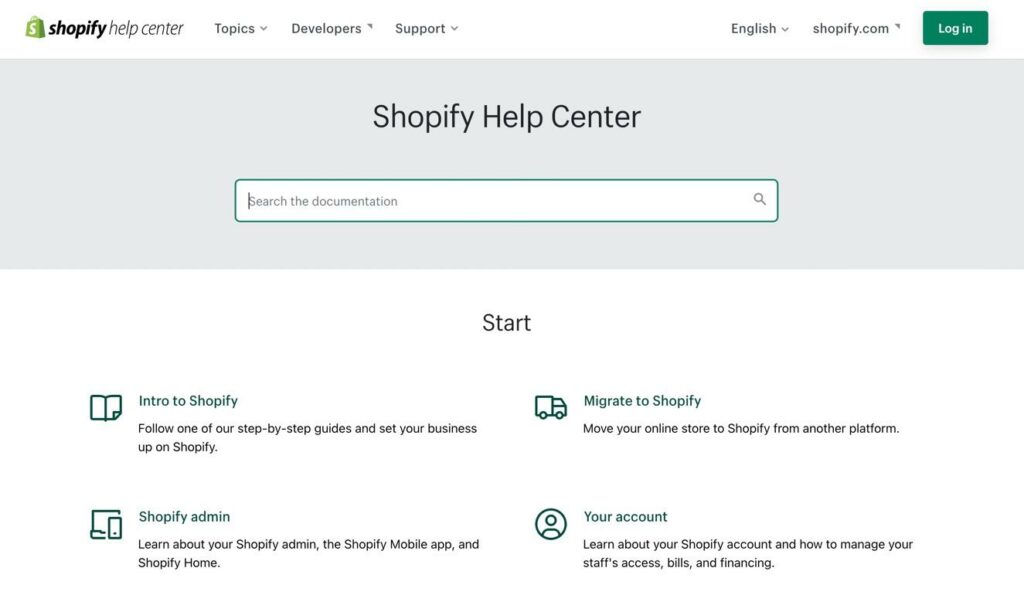
The reason we like the Shopify Help Center so much is because the articles are often complemented by visuals, whether that’s screenshots of the dashboard or videos to guide you through whatever process you have questions about.
Other online resources from Shopify include:
- A consistently updated blog
- Business courses
- Free tools like a business name generator and logo maker
- Podcasts
- A business encyclopedia
- Community events
- A research portal
As for direct/human customer support, Shopify has you covered with:
- An email ticketing system
- An online chat module inside your Shopify dashboard
- Phone support in countries like the US, UK, Australia, New Zealand, India, Malaysia, Singapore, and Indonesia
- 24/7 online support
- Social media accounts like Facebook, Twitter, and Instagram
Shopify Pro #3: Sell Anything You Want—Physical, Digital, Bundled, Etc.
Many ecommerce platforms focus on one or two specific product types, like how Teachable is for selling online courses, or how Kajabi works for monetizing podcasts and communities.
Shopify, however, caters to all business types, regardless of what you’re selling. Now, there are definitely some business types that may prefer a different platform (like how we’d recommend a more focused platform if building an online course website or multi-seller marketplace), but Shopify supports enough product types to ensure you’re never limited to what you sell.
Occasionally, you need a special theme or app, but Shopify still has the foundation for selling anything.
Shopify‘s users have been known to sell:
- Physical products
- Bundled products
- Subscriptions
- Digital products
- Consultations
- Service appointments
- Memberships
- Online classes and workshops
- Live streams
- Digital gift cards
- Event tickets
- Donations
- Quotes and estimates
- Rentals
- Experiences
As of right now, the main product types that are actually built into Shopify include physical and digital products.
However, a quick app installation opens up capabilities for everything from memberships to subscriptions and events to donations.
Shopify Pro #4: Built-in Security
With a self-hosted ecommerce platform, you’re stuck installing extra plugins for site security like two-factor authentication and SSL encryption (required for an ecommerce store).
Shopify, on the other hand, packages all the necessary security components into your subscription.
This way, most of the security measures run in the background, without you having to lift a finger.
With Shopify:
- You receive a pre-installed SSL certificate for encrypting and protecting all transactional information that goes through your site—it’s the law to have an SSL certificate, but many self-hosted platforms make you bring your own
- You can turn on two-factor authentication to prevent brute force login attacks
- Every app developer must go through security and quality checks before publishing their products
- You receive secure hosting with Level 1 PCI Compliance
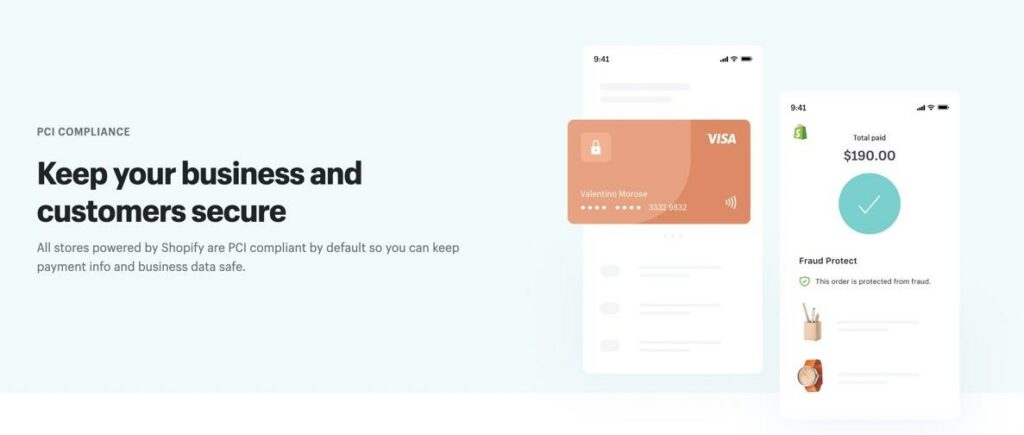
- You have access to account recovery codes and backup data if anything happens to your site or login information
- There are logs for suspicious activity on your site
- Different types of ecommerce fraud gets flagged
- Each site has TLS (Transport Layer Security) for further strengthening the encryption of data across your site (TLS is actually a replacement for SSL, but are often used interchangeably)
- Third-party auditors certify that Shopify meets standards like SOC Type 2 and SOC 3 (certifications for secure information systems)
- You can comply with regional security and privacy laws like CCPA and GDPR
Shopify Pro #5: Incredible Payment Processing Support
Shopify is unmatched in its support of payment processors, with over 100 solutions to choose from.
Competitors often only provide one or two payment gateway options, essentially forcing you into their pricing and policies.

Having freedom to select your payment processing opens up opportunities for selling in different industries, finding cheaper credit card fees, and selling in all countries.
You can use the Payment Gateways page on Shopify’s website to see which ones are available for your country.
As an example, Shopify has a long list of payment processors for US merchants, including:
- Amazon Pay
- 2Checkout
- Shopify Payments
- Authorize.net
- BitPay
- Braintree
- PayPal
- Skrill
- Coinbase Commerce
- Klarna
- QuickBooks Payments
- And many more
Although we’re not a fan of how you’re penalized (extra transaction fee) for using payment gateways outside of Shopify Payments, we will say that Shopify Payments is an incredibly easy-to-use processor. It has simple pricing, easy order management, predictable payouts, and streamlined chargeback management.
Shopify Pro #6: Beautiful Themes and Easy Design Tools
Let’s start with the themes that come with Shopify. First of all, you don’t have to go purchase a theme from a third party.
Shopify provides 98 themes (that’s 89 paid and 9 free), most of which have multiple styles.
These styles turn the themes into entirely different designs, so you’re technically choosing from triple or quadruple the 98 count we mentioned before.

To make things even better, each theme comes equipped with beautiful designs, industry-specific tools, and unique features.
You must do your research on each theme to understand which features you truly need.
Here are some of the theme-specific features you can find from Shopify:
- EU translations
- Quick views of products
- Mega menus
- Sticky headers
- Color swatches
- In-menu promos
- Breadcrumbs
- Stock counters
- Age verifiers
- Back-to-top buttons
- Store locators
- And many more
It’s also worth mentioning that Shopify has its themes categorized rather well, helping you find the perfect theme for your small business, whether you search by industry, catalog size, or features.
You can, for example, browse collections for:
- Trending themes
- Minimalist styles
- Small catalogs
- Large catalogs
- Themes to sell in person
After picking a theme, it’s onto designing the website. Shopify enhances the design experience for all users by providing a beautiful visual editor, where you click and drag modules up and down to reorganize them.
It’s not a true drag-and-drop editor like you’d find with Wix or Elementor, but close to perfect when it comes to seeing a preview of your design and editing most elements.
Shopify Pro #7: Shopify Has The Best App Store You Can Find
App stores have become popular on ecommerce platforms for their ability to expand online stores.
The Shopify App Store is the king of them all, offering apps for:
- Accounting
- Product sourcing
- Marketing and advertising
- SEO
- Live chats
- Online reviews
- Sales channels
- Custom pages and image optimization
- Delivery and shipping
- Operations and success measurement
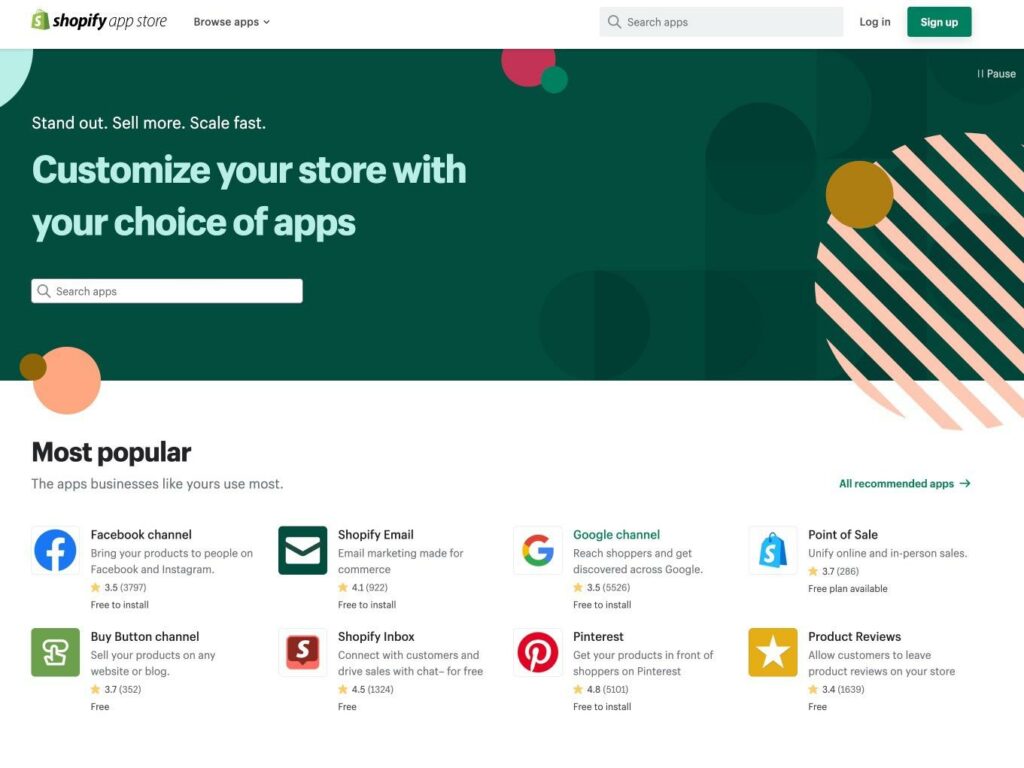
The App Store gets moderated to ensure only the most secure, feature-rich apps make it to the App Store. And the installation process is seamless, where you simply add an app to your store to start using it.
The Shopify App Store has thousands of apps, and many of them are free. However, you may find your recurring app bill increasing quickly if you keep adding paid apps.
Shopify Pro #8: A Powerful, Integrated Point of Sale
When looking at Shopify pros and cons, it’s obvious that the Shopify POS product is one of the main outliers.
It’s one thing to have an ecommerce platform, but some merchants also need a point of sale (POS), and for that POS to integrate with their online store’s inventory, customer database, and orders.
Luckily, there’s a free product (paid for the Pro version) called Shopify POS. It’s a POS software that you can install on any device and sync with an online store (or not).
It has a customizable terminal, and full integration with POS hardware you can either buy from Shopify or a 3rd-party vendor.
This way, you can configure a checkout counter with an iPad, and utilize items like card swipers, cash drawers, and receipt printers.

The most notable hardware item from Shopify is the Shopify POS Go device, which is a durable handheld screen with Shopify POS programmed in.
This allows you to process payments anywhere while still connecting to your databases.
Shopify Pro #9: It’s a Popular, Growing Platform
Popularity is always important when it comes to technology, but that’s particularly true for ecommerce platforms.
You want your website’s platform to have a following; otherwise, it runs the risk of closing shop in the near future, leaving you to transfer all the files elsewhere.
Shopify has grown over the past decade and continues its rise in the ecommerce industry. The platform runs almost 4 million live sites, and there’s a thriving community behind all Shopify products.
Not only does this help ensure the longevity of your ecommerce platform, but it means you’re able to find information about Shopify online.
Numerous blogs talk about Shopify on a regular basis, and you can find forums with rich conversation to solve issues or questions you may have about the system.
Shopify Pro #10: Built-in Marketing and Advertising Tools
Instead of signing up for multiple services to send emails, work on SEO, and manage social media campaigns, Shopify users handle all of that through the dashboard.

You can:
- Build SEO with on-page tools and content creation features
- Run campaigns for email marketing, Facebook Ads, and Google advertisements
- Improve efforts with real-time insights
- Create lasting relationships with customer groups, personalized messages, and automated processes
Shopify Pro #11: Seamless Fulfillment and Product Sourcing Options
Fulfillment and product sourcing doesn’t come by default in Shopify, but there are several free options available to install, and all through the Shopify dashboard.
One of the most accessible ways to fulfill products is through the Shopify Fulfillment Network.
This is a 3rd-party logistics operation where merchants send and store all merchandise to Shopify warehouses. Shopify then accepts orders from your store, packages them, and ships them to customers, all for a monthly fee.

In addition, you can opt for Shopify apps that assist with product sourcing, like how the Printful app allows for print-on-demand selling, or how DSers works well for locating AliExpress items and dropshipping them to customers.
Shopify Pro #12: There’s a Cheap Plan for Content Creators
Although we highly recommend the $29 Basic plan for most ecommerce merchants (since that gets you an actual online store with shopping cart and checkout), Shopify also provides a $5 Starter plan for content creators and influencers who want to start selling merchandise.

The Starter plan serves those creators by letting them generate “Buy” buttons and links to sell on social media and messaging apps.
There’s even a link shortener and mobile landing page to include a list of products in social media bios.
Shopify Cons
While compiling our Shopify pros and cons list, it became apparent that the pros outweigh the cons quite a bit.
However, some merchants may find that one or two cons makes it impossible to run their businesses, so it’s important to consider Shopify’s downsides before you commit to the entire platform.
Shopify Con #1: Never-ending Payments
As a SaaS (software as a service) provider, Shopify charges a recurring fee to use its services and products.
The main plans are reasonable, but it’s also leaning into the growing trend of subscription pricing for everything.
The good news is that paying $29 to $299 per month for Shopify (more for Shopify Plus) can easily be recouped with a few sales.
And you’d have to pay that for hosting, and other features, when working with a self-hosted platform.
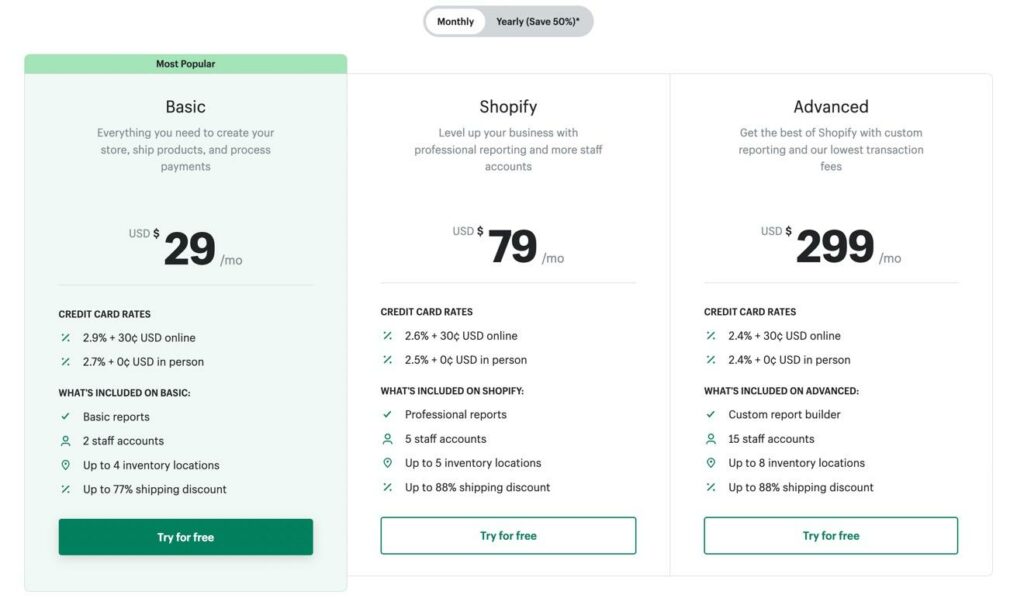
However, it’s essential to remember that this is another subscription you have to sign up for. Those recurring costs will never end as long as you’re running a business on Shopify. In fact, they’ll most likely grow as your business does.
As an alternative, some ecommerce platforms sell as traditional software, where you pay a one-time fee and that’s it.
Shopify Con #2: Transaction Fees for Non-Shopify Payment Processing
Shopify Payments offers top-notch processing, and its users don’t have any additional transaction fees they have to pay outside of the usual credit card processing fees; those go to the credit card companies, not Shopify—and they’re required from every shopping cart software.
And it’s great that Shopify supports over 100 other payment gateways outside of Shopify Payments. However, all of those processors have one big limitation: you must pay a 3rd-party transaction fee to use them with Shopify.
So, Shopify is essentially incentivizing you to use Shopify Payments. From a different perspective, you could also see this as a punishment for using anything outside of Shopify Payments.
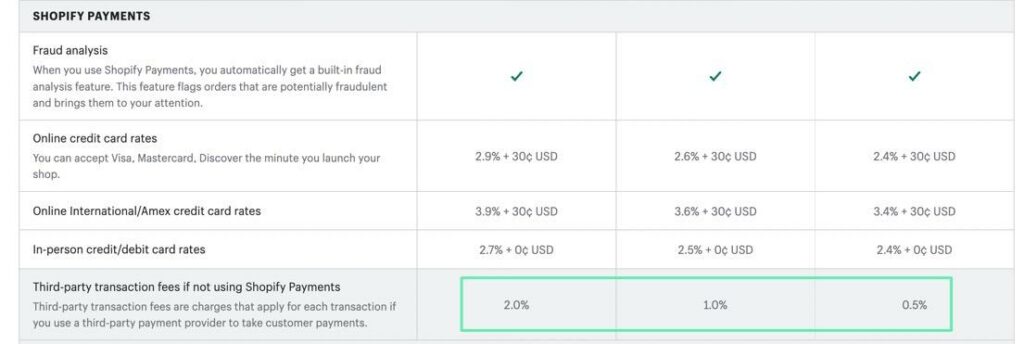
As of this article, non-Shopify Payments users are subject to these 3rd-party transaction fees (on top of the credit card fees):
- 2% for the Basic plan
- 1% for the Shopify plan
- 0.5% for the Advanced Shopify plan
Shopify Con #3: Limited Free Themes and Expensive Paid Themes
There was once a time when Shopify offered a plentiful selection of free themes, but that count has dwindled over the years.
It’s clear they’re trying to make more money from their theme sales, considering you can now only find 9 free themes in the Shopify Theme Store.
Not only that, but the Shopify pricing for premium themes has risen.
We used to see Shopify themes sell for around $80 to $100, but the standard price is looking more like $300 to $350 nowadays. Luckily, that’s a onetime fee, so you can recoup that quickly once you start making sales.
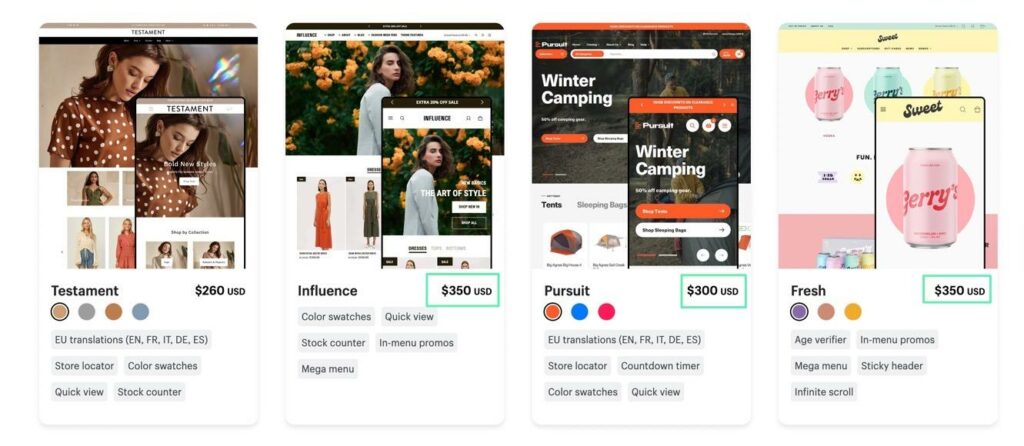
Shopify Con #4: Apps Can Get Expensive
Similar to a smartphone, Shopify is made to work with apps. This adds great flexibility for expanding your store, but also means Shopify doesn’t already have some basic ecommerce functionality built in. It instead assumes that Shopify merchants will install apps to make up for certain lacking features.
Unfortunately, once you add a handful of premium Shopify apps, your monthly bill starts to creep ever higher.
For example, some sellers simply must have more advanced shipping features; in that case you would have to spend an extra $9.99 to $159.99 per month to print shipping labels and receive tracking codes with an app like ShipStation.
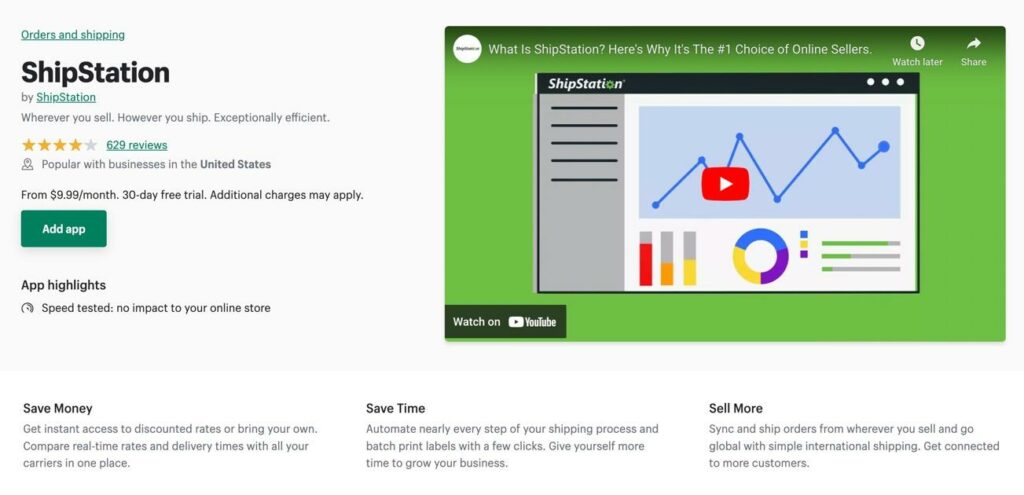
Shopify Con #5: It’s Tough to Migrate Away from Shopify
It’s not quite as easy as it should be to export some of your site content. Blog post content gets locked up into Shopify, turning it into a process of copying and pasting into a new platform.
And you can’t simply export the code files from a webpage and publish it to another platform like WordPress.
Shopify uses a unique coding language, so there’s limited compatibility with other systems. In short, you often have to completely redesign your website, and duplicate that previous content, if attempting to move to another platform.
Luckily, you can always export a CSV file for things like orders and products, but there’s no direct transfer for your content and site design.
Shopify Con #6: Less Popular Coding Language
When you go with Magento, WordPress, Squarespace, or Wix, you can usually rest easy knowing that the programming language is based on well-known standards like PHP, CSS, and HTML.
Shopify, however, chose to build its system on Ruby, which is growing in popularity, but the Liquid programming language is not exactly the most commonly used.
This means that you’ll have a tougher time making advanced customizations, migrating your content, and integrating with other systems (if you can’t find an app for that).
To put it simply, most developers know how to handle PHP, CSS, and HTML. So, you can go out and hire a developer to customize your site however you want. With Liquid, however, you must locate a developer who’s trained specifically on that language.
It’s also harder to find documentation for Liquid if you intend to complete quick DIY fixes to your site.
Shopify Con #7: The Limited Blogging Interface
We like that Shopify at least attempts to include a blogging interface with its ecommerce platform. Many competitors don’t.
Yet, when compared to WordPress, blogging is far too simplified, buggy, and plain boring when presented on the frontend.
We’d like to see a more user-friendly, feature-rich blogging interface in the future, considering so many ecommerce brands must create content to attract customers to their sites. Currently, blogging seems like an afterthought for Shopify.
Final Thoughts About the Shopify Pros and Cons
Our Shopify review of its pros and cons comes down to what you need for your specific online business. Is it necessary to have an all-in-one ecommerce platform with hosting included?
Then Shopify makes sense for you. Is it a dealbreaker if you can’t migrate to another platform with ease, or if you must pay a transaction fee for a non-Shopify Payments processor?
Then Shopify may not be the ecommerce solution for you.
We hope this list of Shopify pros and cons has helped you understand where the platform excels and where it may fall short.
If you need any clarification that may expand upon these pros and cons of Shopify, please let us know in the comments section below!




Comments 0 Responses